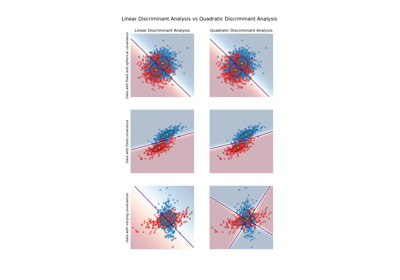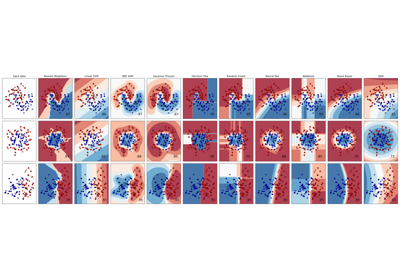sklearn.discriminant_analysis.QuadraticDiscriminantAnalysis¶
- class sklearn.discriminant_analysis.QuadraticDiscriminantAnalysis(*, priors=None, reg_param=0.0, store_covariance=False, tol=0.0001)[source]¶
Quadratic Discriminant Analysis.
A classifier with a quadratic decision boundary, generated by fitting class conditional densities to the data and using Bayes’ rule.
The model fits a Gaussian density to each class.
New in version 0.17: QuadraticDiscriminantAnalysis
Read more in the User Guide.
- Parameters:
- priorsarray-like of shape (n_classes,), default=None
Class priors. By default, the class proportions are inferred from the training data.
- reg_paramfloat, default=0.0
Regularizes the per-class covariance estimates by transforming S2 as
S2 = (1 - reg_param) * S2 + reg_param * np.eye(n_features), where S2 corresponds to thescaling_attribute of a given class.- store_covariancebool, default=False
If True, the class covariance matrices are explicitly computed and stored in the
self.covariance_attribute.New in version 0.17.
- tolfloat, default=1.0e-4
Absolute threshold for a singular value to be considered significant, used to estimate the rank of
XkwhereXkis the centered matrix of samples in class k. This parameter does not affect the predictions. It only controls a warning that is raised when features are considered to be colinear.New in version 0.17.
- Attributes:
- covariance_list of len n_classes of ndarray of shape (n_features, n_features)
For each class, gives the covariance matrix estimated using the samples of that class. The estimations are unbiased. Only present if
store_covarianceis True.- means_array-like of shape (n_classes, n_features)
Class-wise means.
- priors_array-like of shape (n_classes,)
Class priors (sum to 1).
- rotations_list of len n_classes of ndarray of shape (n_features, n_k)
For each class k an array of shape (n_features, n_k), where
n_k = min(n_features, number of elements in class k)It is the rotation of the Gaussian distribution, i.e. its principal axis. It corresponds toV, the matrix of eigenvectors coming from the SVD ofXk = U S VtwhereXkis the centered matrix of samples from class k.- scalings_list of len n_classes of ndarray of shape (n_k,)
For each class, contains the scaling of the Gaussian distributions along its principal axes, i.e. the variance in the rotated coordinate system. It corresponds to
S^2 / (n_samples - 1), whereSis the diagonal matrix of singular values from the SVD ofXk, whereXkis the centered matrix of samples from class k.- classes_ndarray of shape (n_classes,)
Unique class labels.
- n_features_in_int
Number of features seen during fit.
New in version 0.24.
- feature_names_in_ndarray of shape (
n_features_in_,) Names of features seen during fit. Defined only when
Xhas feature names that are all strings.New in version 1.0.
See also
LinearDiscriminantAnalysisLinear Discriminant Analysis.
Examples
>>> from sklearn.discriminant_analysis import QuadraticDiscriminantAnalysis >>> import numpy as np >>> X = np.array([[-1, -1], [-2, -1], [-3, -2], [1, 1], [2, 1], [3, 2]]) >>> y = np.array([1, 1, 1, 2, 2, 2]) >>> clf = QuadraticDiscriminantAnalysis() >>> clf.fit(X, y) QuadraticDiscriminantAnalysis() >>> print(clf.predict([[-0.8, -1]])) [1]
Methods
Apply decision function to an array of samples.
fit(X, y)Fit the model according to the given training data and parameters.
Get metadata routing of this object.
get_params([deep])Get parameters for this estimator.
predict(X)Perform classification on an array of test vectors X.
Return log of posterior probabilities of classification.
Return posterior probabilities of classification.
score(X, y[, sample_weight])Return the mean accuracy on the given test data and labels.
set_params(**params)Set the parameters of this estimator.
set_score_request(*[, sample_weight])Request metadata passed to the
scoremethod.- decision_function(X)[source]¶
Apply decision function to an array of samples.
The decision function is equal (up to a constant factor) to the log-posterior of the model, i.e.
log p(y = k | x). In a binary classification setting this instead corresponds to the differencelog p(y = 1 | x) - log p(y = 0 | x). See Mathematical formulation of the LDA and QDA classifiers.- Parameters:
- Xarray-like of shape (n_samples, n_features)
Array of samples (test vectors).
- Returns:
- Cndarray of shape (n_samples,) or (n_samples, n_classes)
Decision function values related to each class, per sample. In the two-class case, the shape is (n_samples,), giving the log likelihood ratio of the positive class.
- fit(X, y)[source]¶
Fit the model according to the given training data and parameters.
Changed in version 0.19:
store_covarianceshas been moved to main constructor asstore_covarianceChanged in version 0.19:
tolhas been moved to main constructor.- Parameters:
- Xarray-like of shape (n_samples, n_features)
Training vector, where
n_samplesis the number of samples andn_featuresis the number of features.- yarray-like of shape (n_samples,)
Target values (integers).
- Returns:
- selfobject
Fitted estimator.
- get_metadata_routing()[source]¶
Get metadata routing of this object.
Please check User Guide on how the routing mechanism works.
- Returns:
- routingMetadataRequest
A
MetadataRequestencapsulating routing information.
- get_params(deep=True)[source]¶
Get parameters for this estimator.
- Parameters:
- deepbool, default=True
If True, will return the parameters for this estimator and contained subobjects that are estimators.
- Returns:
- paramsdict
Parameter names mapped to their values.
- predict(X)[source]¶
Perform classification on an array of test vectors X.
The predicted class C for each sample in X is returned.
- Parameters:
- Xarray-like of shape (n_samples, n_features)
Vector to be scored, where
n_samplesis the number of samples andn_featuresis the number of features.
- Returns:
- Cndarray of shape (n_samples,)
Estimated probabilities.
- predict_log_proba(X)[source]¶
Return log of posterior probabilities of classification.
- Parameters:
- Xarray-like of shape (n_samples, n_features)
Array of samples/test vectors.
- Returns:
- Cndarray of shape (n_samples, n_classes)
Posterior log-probabilities of classification per class.
- predict_proba(X)[source]¶
Return posterior probabilities of classification.
- Parameters:
- Xarray-like of shape (n_samples, n_features)
Array of samples/test vectors.
- Returns:
- Cndarray of shape (n_samples, n_classes)
Posterior probabilities of classification per class.
- score(X, y, sample_weight=None)[source]¶
Return the mean accuracy on the given test data and labels.
In multi-label classification, this is the subset accuracy which is a harsh metric since you require for each sample that each label set be correctly predicted.
- Parameters:
- Xarray-like of shape (n_samples, n_features)
Test samples.
- yarray-like of shape (n_samples,) or (n_samples, n_outputs)
True labels for
X.- sample_weightarray-like of shape (n_samples,), default=None
Sample weights.
- Returns:
- scorefloat
Mean accuracy of
self.predict(X)w.r.t.y.
- set_params(**params)[source]¶
Set the parameters of this estimator.
The method works on simple estimators as well as on nested objects (such as
Pipeline). The latter have parameters of the form<component>__<parameter>so that it’s possible to update each component of a nested object.- Parameters:
- **paramsdict
Estimator parameters.
- Returns:
- selfestimator instance
Estimator instance.
- set_score_request(*, sample_weight: bool | None | str = '$UNCHANGED$') QuadraticDiscriminantAnalysis[source]¶
Request metadata passed to the
scoremethod.Note that this method is only relevant if
enable_metadata_routing=True(seesklearn.set_config). Please see User Guide on how the routing mechanism works.The options for each parameter are:
True: metadata is requested, and passed toscoreif provided. The request is ignored if metadata is not provided.False: metadata is not requested and the meta-estimator will not pass it toscore.None: metadata is not requested, and the meta-estimator will raise an error if the user provides it.str: metadata should be passed to the meta-estimator with this given alias instead of the original name.
The default (
sklearn.utils.metadata_routing.UNCHANGED) retains the existing request. This allows you to change the request for some parameters and not others.New in version 1.3.
Note
This method is only relevant if this estimator is used as a sub-estimator of a meta-estimator, e.g. used inside a
Pipeline. Otherwise it has no effect.- Parameters:
- sample_weightstr, True, False, or None, default=sklearn.utils.metadata_routing.UNCHANGED
Metadata routing for
sample_weightparameter inscore.
- Returns:
- selfobject
The updated object.
Examples using sklearn.discriminant_analysis.QuadraticDiscriminantAnalysis¶

Linear and Quadratic Discriminant Analysis with covariance ellipsoid
